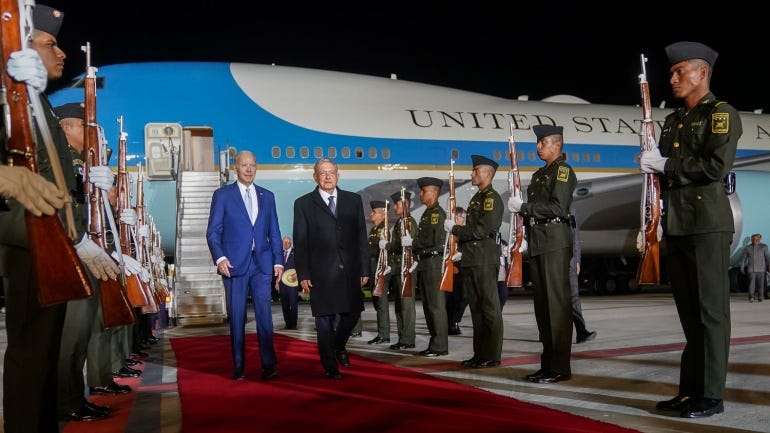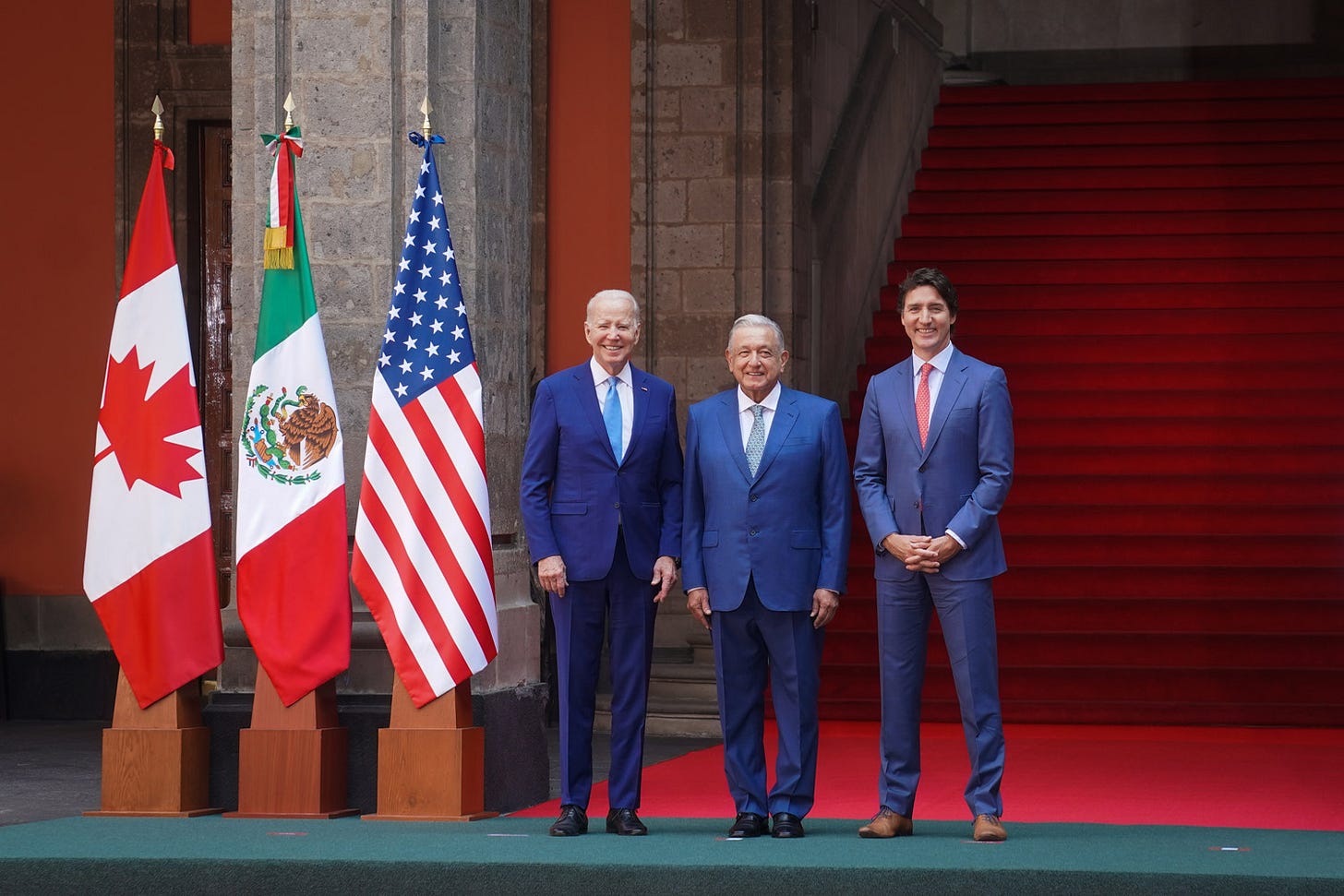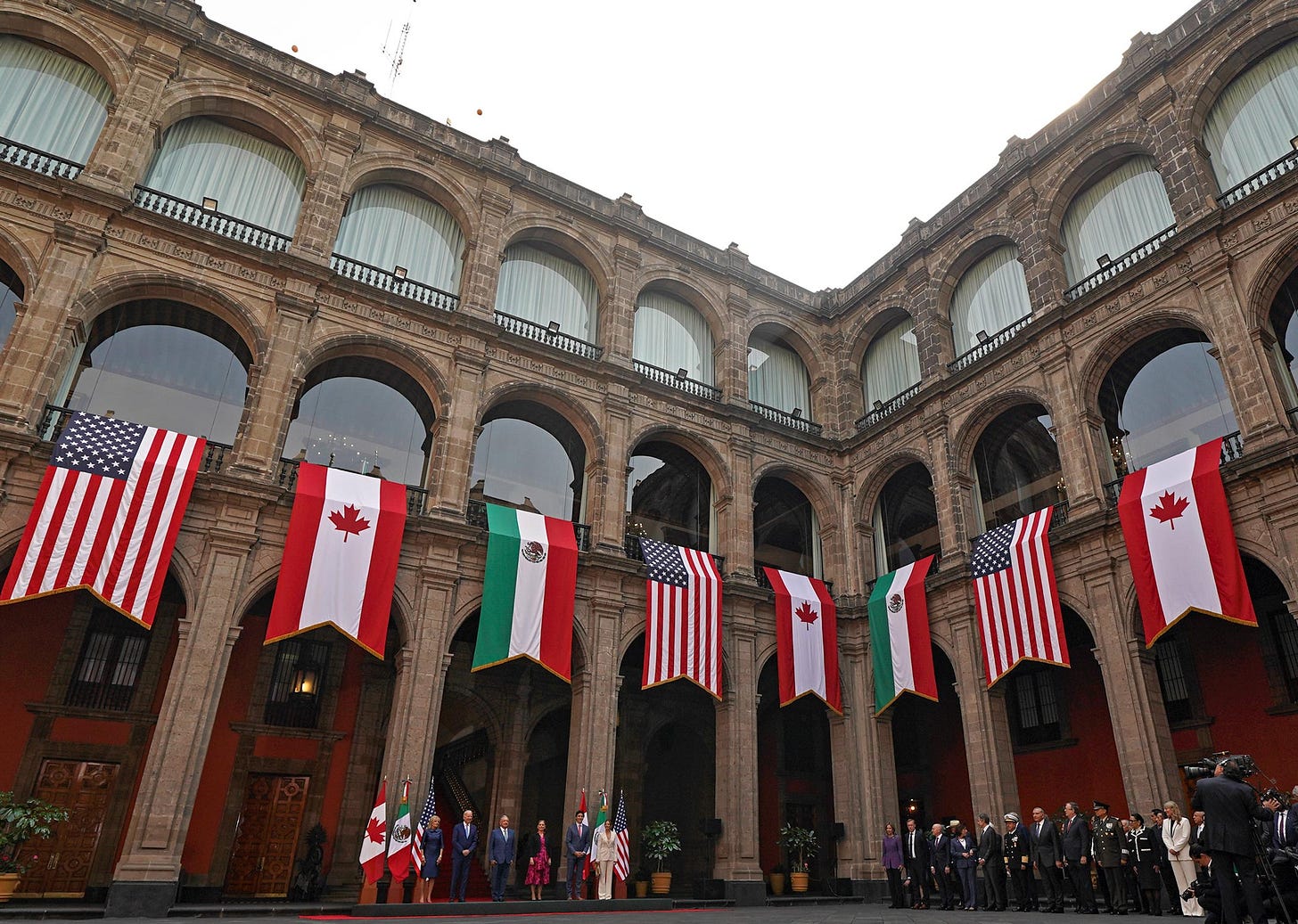Mexico serves up spectacular arrest ahead of Biden visit
Mexico captures El Chapo's son on the eve of Biden's first trip south of the border for North American leaders' summit
Joe Biden touched down Jan. 8 at a little-used airport in the boonies north of Mexico City for his first official trip to Mexico as president – a 48-hour jaunt south for the North American leaders’ summit amid bilateral tensions over trade, security and immigration.
Mexican President Andrés Manuel López Obrador (AMLO) met Biden and later accompanied the US president on the 30-mile ride in the “beast” from the Felipe Ángeles International Airport (AIFA) to Biden’s hotel in the posh Polanco district. The trip took more than an hour, according to the White House press pool, which said, “After a very bumpy ride, the POTUS motorcade arrived at the RON at 8:50 pm.”




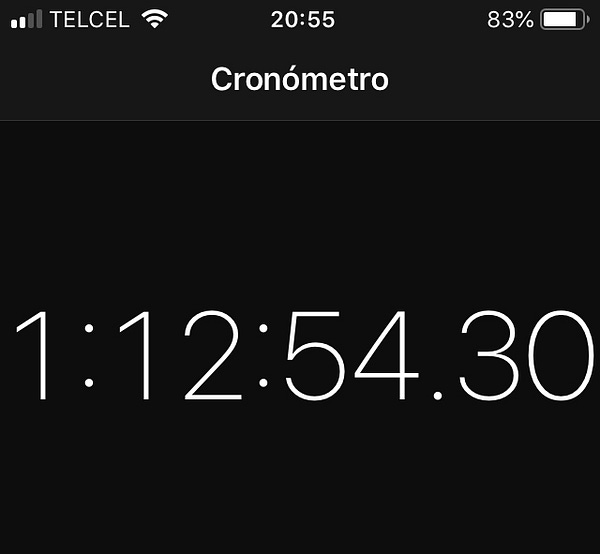
“President Biden’s expression was: ‘This is a great airport,’” AMLO at his Monday morning press conference. “The Secret Service, which behaved very well, took us for a spin around the entire airport.”
Based on AMLO’s repeated promotion of Biden’s arrival at AIFA in the lead up to the summit, Air Force One landing at the airport might have marked the most important part of the summit for the Mexican president.
The foreign ministry subsequently took all of its ambassadors and consuls – in town for an annual meeting – to the airport (which lacks flights to the United States because the FAA downgraded Mexican aviation safety.) The diplomats all dutifully tweeted about the airport – one of the white elephant mega projects AMLO’s prioritized since taking office in December 2018.





Nothingburger of a summit – preceded by a spectacular arrest and highlighted by a 28-minute AMLO soliloquy
The emphasis on the president’s arrival (and that of the Canadian prime minister) illustrated AMLO’s instance that the best foreign policy is domestic policy.
And hosting the North American leaders’ summit offered a chance for AMLO to rope the leaders of the United States and Canada into his small potatoes’ priorities – the Felipe Ángeles International Airport; the Tren Maya, which will circle the Yucatán Peninsula; a train across the Isthmus of Tehuantepec; and a refinery in Tabasco state.
AMLO’s antics kept stealing the show in Mexico – most notably his 28-minutes of spitballing at the leaders’ press conference in response to a question on immigration. From a dispatch by Bloomberg News:
“He touched on malaria vaccines, scholarships for disabled children, his Mayan train project and ‘beautiful, well-dressed men and women with jewelry’ in TV crime dramas. He talked about fentanyl and vapes and, toward the very end, asked Biden to help Mexican immigrants in the US.
“Unaccustomed to Lopez Obrador’s daily press conferences, which often stretch to near three hours, Biden and Trudeau stared politely at their lecterns, their feet, the sky. Anywhere that might provide distraction.”
The summit’s prelude was punctuated by the arrest of Ovidio Guzmán, son of imprisoned Sinaloa Cartel leader Joaquín “El Chapo” Guzmán – driving speculation the AMLO administration was trying to get into Biden’s good graces by detaining a notorious crime boss. (More on the arrest below).
Same old, same old
The latest edition North American leaders’ summit promised the usual talk of improving security, deepening economic integration and resolving immigration questions.
It came at a unique time as the promise of nearshoring appears to be becoming real as companies look to move production from China to markets closer to the United States. Sources in Mexico speak of enormous interest from foreign investors and the operators of industrial parks say they’re lacking space due to crushing demand.
But AMLO’s indifference to foreign investors is dampening demand – as demonstrated by a May 2022 feature in the Financial Times. A Chihuahua state official in the factory hub of Ciudad Juárez told this newsletter that AMLO’s energy policies of thwarting competition to the state-owned Federal Electricity Commission (CFE) is preventing industrial parks and properties there from accessing the electric grid.
Continental integration
AMLO again floated his fanciful idea of continental integration with all of the Americas, which contradicted his constant talk of “sovereignty” and caterwauling over “intervention.” He said at the leaders’ press conference:
“We addressed as priorities economic and commercial integration, as I’ve already expressed, of all of the American continent, along with the wellbeing of the pueblos and the new cooperative relationship, leaving behind hegemonic interventionism.”
The poverty of AMLO’s foreign policy
AMLO professes a fondness for Mexico’s traditional foreign policy of non-intervention – known as the Estrada Doctrine, which the Institutional Revolutionary Party (PRI) cynically practiced to rebuff criticism of its excesses (though AMLO has regularly lent support to Latin American lefties he considers fellow travellers and intervened in their countries’ domestic affairs.)
He boycotted of the Summit of the Americas hosted by Biden in June in Los Angeles over the host not invited Cuba, Nicaragua and Venezuela – all non-democratic regimes. Other lefty governments in the region followed suit. AMLO again chided Biden on supposed US attitudes toward Latin America, saying after Biden’s arrival to the National Palace:
“I sustain that it’s time to stop with this neglect, this abandonment, this scorn toward Latin America and the Caribbean, opposed to the ‘good neighbour policy’ of that titan of liberty, President Franklyn Delano Roosevelt.
“President Biden, you have the key to open and substantially improve relations between all countries of the American continent.”
Biden responded to AMLO:
“Just in the last 15 years, we’ve spent billions of dollars in the hemisphere, tens of billions of dollars in the hemisphere. … What we have to do is what you’ve done [referring to AMLO’s exporting an unproven tree-planting program to Central America to stop migration] and I compliment you on it: We have to continue to support and build democratic institutions in the hemisphere.”
Selective non-intervention

AMLO, openly ecstatic that a left-wing leader retook power in Brazil, joined Biden and Trudeau in a statement condemning the Jan. 7 raids on Brazil’s seats of government by supporters of former president Jair Bolsonaro.
Mexico’s president got along well with former president Donald Trump, saying after the latter’s November announcement as a 2024 candidate, “He’s a capitalist and isn’t perfect, but he’s a good person.”
Such difference for Trump contrasts with discourtesy for Biden, including a boycott of the Summit of the Americas in Los Angeles. AMLO most notably delayed recognizing Biden’s election win, saying he wanted all legal challenges to be exhausted and citing his own history of suffering a supposed election fraud in 2006 – an election he lost narrowly to Felipe Calderón and international observers considered free and fair. (Such caution with the 2020 U.S. election vanishes with elections in South America, where AMLO has been quick to accept early results favouring his preferred candidates.)
He cited “non-intervention” as reasons for staying silent on the Jan. 6, 2021, raid on the U.S. Capitol – while also enjoying good relations with former president Donald Trump – saying the day after:
“We’re not going to intervene in these affairs which correspond to Americans to resolve. That’s our policy. That’s what I can comment.”
Biden arrives from the border
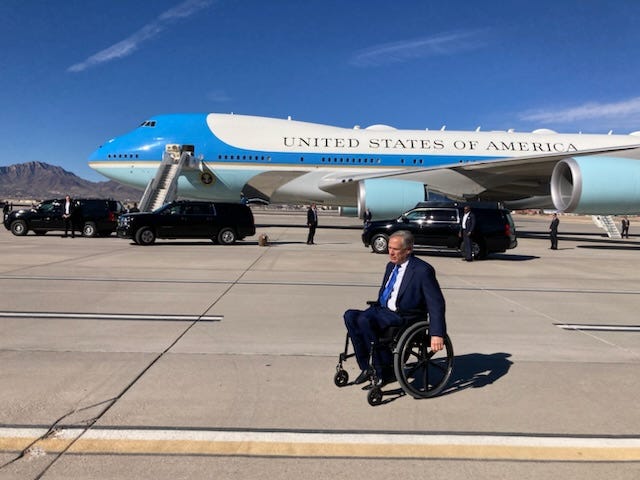
Biden arrived in Mexico City after making his first visit to the border as president. He stopped for several hours in El Paso en route to Mexico, visiting the Bridge of the Americas Port of Entry, the border barrier separating the United States and Mexico and the El Paso County Migrant Services Support Center. He said little to the press other than, “They need a lot of resources. We’re going to get it for them.”
Earlier in January the president announced an expansion of Title 42 to migrants from Haiti, Nicaragua and Cuba – joining Venezuelans, who were included under the pandemic-era measure in October.
The administration also authorized 30,000 migrants monthly from the four countries – Venezuela, Haiti, Nicaragua and Cuba – to legally enter the United States monthly so long as they had sponsors and hadn’t stepped foot in Mexico or Panama. Mexico agreed to accept 30,000 returnees from those countries “who fail to use these new pathways.”
Mexico went along with the proposal because of the results of the program for Venezuelans, according to Roberto Velasco, undersecretary for North America. He told this newsletter.
“The US opened a legal pathway for people to come in (and) we saw a drop in irregular migration flows from Venezuela of 94 per cent. … The human smugglers are losing a very substantial amount money and are not being able to put these people at great risk.”
A new app for admission to US – another version of ‘metering’?
The administration also announced the introduction of an app known as CBP One, which it described as an “online appointment portal to reduce overcrowding and wait times at US ports of entry” after Title 42 is lifted for non-citizens in waiting in Mexico and Central America.
One analyst compared the app to the old process of “metering,” in which potential asylum seekers waiting in Mexico would put their name on lists and be called to US ports of entry to present their claim. Metering existed prior to the pandemic until Title 42 started being applied. US ports of entry would call a certain number of migrants from the list – presumably based on capacity, though the criteria was uncertain – to be processed each day.
The lists were managed in Mexico by various civic groups or government officials – with accusations rife of favouritism and corruption. One official in a border town told this newsletter that the civil society organization managing the list there charged more than $100 to migrants who wanted to be moved higher and the list, which would allow them to be called sooner. The analyst said of the CBP One app:
“It would be the first time that CBP would run its own metering process instead of outsourcing it to Mexican list managers.”
Summit statement
The summit statement read like a pro forma list of aspirations: achieving more economic cooperation, combatting drugs and the fentanyl crisis, addressing issues like inequality, and taking action on climate change – an issue AMLO has showed scant interest in addressing, despite repeated visits from US climate envoy John Kerry. They also spoke of making migration safer, including: “Building on an initiative under the last NALS to further help migrants access legal pathways in-person, and announcing a partnership on a new centre in southern Mexico with strong private sector support.”
The inclusion a of a new “centre” in southern Mexico apparently came as news to AMLO, who said no such plans existed.

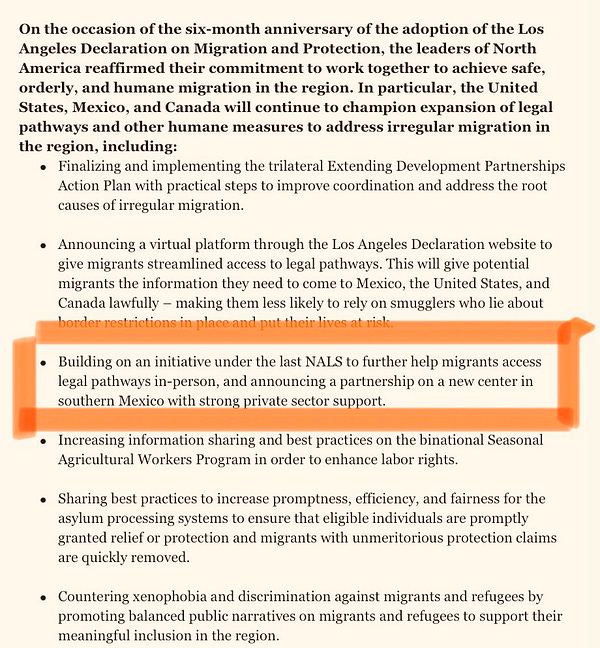
EL CHAPO’S SON CAPTURED; A PRE-SUMMIT GIFT?
Mexican soldiers captured Ovidio Guzmán, son of convicted Sinaloa Cartel kingpin Joaquín ‘El Chapo’ Guzmán, during the predawn hours of Jan. 5, triggering spasms of violence as sicarios mobilized to thwart the arrest – as occurred previously in 2019.
Guzmán, known as ‘El Ratón’ (the mouse), was captured in a hamlet of Jesús María on the outskirts of Culiacán, the Sinaloa state capital. Video on social media showed a helicopter opening fire on a residence – replicating an act from 2017 in the state of Nayarit, which AMLO has long criticized as an example of the excesses his “hugs, not bullets” security policy aims to avoid. The Associated Press reported:
“The army responded [to sicarios firing .50 calibre weapons] by calling in Blackhawk helicopter gunships to attack a convoy of 25 cartel vehicles, including truck-mounted cartel gun platforms, on Thursday. The running shootouts killed one Culiacan police officers, and wounded 17 police officers and 35 military personnel.”
The Defence Secretariat deployed 3,000 soldiers to Sinaloa for the operation, which claimed 29 lives – including 10 uniformed members, whose funeral AMLO didn’t attend.
Twice captured
The younger Guzmán was previously arrested in October 2019, but federal forces were forced to surrender him after cartel gunmen caused chaos in Culiacán and Sinaloa – burning buses, blocking roads, closing the airport – took soldiers hostage and attacked a complex where military families resided. AMLO has repeatedly claimed responsibility for ordering the release of Ovidio Guzmán, boasting in his morning news conferences that the decision saved lives.
Guzmán was transported to Mexico City after his most recent arrest, though sicarios stormed the Culiacán airport and shot at aircraft – striking an AeroMexico aircraft taxiing for takeoff. (The flight to Mexico City was cancelled.) A video uploaded to social media showed passengers cowering as the gunfire rang out.

Stopped by a traffic patrol?
Defence secretary Gen. Louis Cresencio Sandoval insisted after the arrest that Guzmán was captured after being stopped by a traffic patrol. Interior minister Adán Augusto López said later:
“He was arrested ‘en flagrancia’ for various crimes: possessions of weapons for exclusive army use, attempted homicide and others. But he was turned over to the federal prosecutor’s office, which executed the arrest warrant in terms of extradition.”
Analysts didn’t buy that explanation – which was curious considering the impunity Los Chapitos enjoyed in Sinaloa. Writing in the newspaper El Universal, security analyst Alejandro Hope said:
“It was an effort that required six months of preparation, intensive use of intelligence, the deployment of at least 900 members of the Army and the National Guard, including members of elite units, and the use of highly sophisticated equipment, including helicopter gunships.”
But the government hadn’t built a case against Ovidio Guzmán – so they supposedly caught him committing some crime. Hope said of the case against Guzmán:
“In the three years and three months since the last attempted capture, nobody bothered to built a judicial investigation, capable of holding up in court, against Ovidio. Nothing on organized crime. Nothing on narcotics trafficking. Nothing on the long history of violence attributed to this person. The only thing that Mexico has against Guzmán is the tried and true tactic of ‘la flagrancia.’
“For all practical purposes, the justice system has only two instruments to combat criminal organizations: criminal flagrance and extradition.”
Journalist Anabel Hernández, who has investigated the Mexican underworld for years and focused on the Sinaloa Cartel, told Radio Formula:
“We have a government that during these years has done zero … to dismantle Los Chapitos’ criminal network. There have been no big property seizures, no bank accounts seized.
“The arrest that was executed against Ovidio, and that is where, I repeat, the Mexican government is like ‘I’m very sorry, almost, they almost forced me, I didn’t want to.’ It’s that they don’t have any criminal accusations. There is no file open in the federal prosecutor’s office for the crimes committed by Los Chapitos. It’s incredible that they have been executing people for years, kidnapping people, terrorizing in Culiacán, the culiacanazo.”
Curious timing

Ovidio Guzmán reputedly forms part of a Sinaloa Cartel faction known as “Los Chapitos” – “Little Chapos” – led by the sons of El Chapo, who is imprisoned in a Colorado penitentiary. US officials offered a $5 million reward for his capture and accused him in 2021 of overseeing the production of up to 5,000 pounds monthly of methamphetamines – though analysts also say the Sinaloa Cartel is deeply involved in producing and smuggling fentanyl.
A Mexican reporter asked Biden about Guzmán’s arrest and taking action on fentanyl during the North American leaders’ summit press conference, but AMLO quickly intervened and gave a non-answer.


The timing of the Guzmán arrest raised eyebrows in Mexico, where AMLO has never had a cross word for narcos and has showed a shocking deference for the Sinaloa Cartel and El Chapo’s family – even stopping on a trip through the rugged Sierra Madre Mountains to great his mother.
Observers in Mexico largely interpreted the arrest a gesture ahead of Biden’s visit – with former Mexican intelligence chief Guillero Valdés remarking:
“Apparently the goal is to please Biden and US security agencies and nothing else. I suppose they will extradite him as soon as possible. The request has been made for three years and it is also not known what he is accused of by the FGR (federal prosecutor’s office). They didn’t even inform us if there is.”

Mexican foreign minister Marcelo Ebrard denied any connection between the summit and the arrest, saying the US had requested Guzmán’s extradition in 2019.
Symbolic capture?
The impact of Guzmán’s arrest on Los Chapitos and the Sinaloa Cartel remains an open question – with most analysts positing his brothers were the real bosses. It also raised the uncomfortable question of whether Mexico has been making symbolic captures – such as Rafael Caro-Quintero, a top priority for the DEA, though seen a modest player at his advanced age. Anabel Hernández told Radio Formula:
“Saying that you detained a member of this organization is not the same as saying that it’s a strong blow to the Sinaloa Cartel. … It’s that Ovidio isn’t all that significant. Los Chapitos are Iván Archivaldo and Alfredo. They’re the bosses.”
Writing in the Washington Post, investigative journalist Peniley Ramírez highlighted the 2017 grand jury indictment of Ovidio Guzmán and his brother Joaquín Guzmán López from a District of Columbia court. The indictment accused the brothers “of trafficking minimal amounts of drugs in comparison with other family members. …His role is not detailed, who he would have associated with or what other members of the family clan worked with him.” She continued:
“Judicial records show that Ovidio is not the heir to the Sinaloa Cartel, rather an operator for his older brothers. His arrest confirms that Mexico seeks to capture middle-range drug traffickers with a media presence.”
The end of ‘hugs, not bullets’?

AMLO insisted after the capture of Ovidio Guzmán that his security strategy of “hugs, not bullets,” would continue – though analysts suggested the arrest in Sinaloa shattered that illusion.
Ismael Bojorquez, director of the local news outlet Riodoce, which has won acclaim for its coverage of Sinaloa crime, said the president’s leniency towards organized crime encouraged the kinds of mobilizations common in cities such as Culiacán. He told the AP:
“They [cartels] have taken advantage of these four years to organize themselves, arm themselves, strengthen their structures, their finances,” he said. “I believe there are more weapons than three years ago. All of organized crime’s armies have strengthened, not just the Chapitos, and this is the price that society is paying for this strategy of the federal government.”




